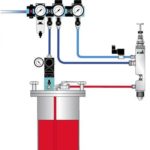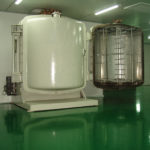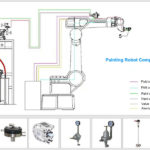Electrophoresis coating(E-coating) is a popular surface treatment technology which is widely used for iron, steel, alloy alluminum and almost all hardware production. However, it’s not an easy work to have the process well going as it requires professional technologies and personal experience over the various equipments. In this article we will briefly introduce the process control of electrophoresis coating.
Electrophoretic coating process
The basic procedures of electrophoresis coating including:
Loading → ultrasonic degreasing → water rinsing → pure water rinsing → pure water rinsing → electrophoretic coating → pure water rinsing → pure water rinsing → pure water washing → drying → unloading.
Key points for process control in each stage
1. After the workpiece is formed and before loading to coating system, the surface should be wired or chemically polished before electrophoresis coating.
2. Hanging: The hanging tool is required to be clean, contact points are good, and the workpiece is firm and does not shake.
3. Ultrasonic degreasing: take K-106A ultrasonic oil and wax removal agent as an example. Prepare the tank according to the ratio of K-106A: pure water = 1:5. The temperature is controlled at 0~50°C and the time is selected. 1~10min.
4. Pure water rinsing: The pure water quality must strictly control the conductivity <5μs/cm, and the conductivity in the last rinsing tank before entering the tank shall not be higher than 10μs/cm.
5. Red copper color electrophoresis: take K-8087 polyurethane acrylic cathodic electrophoresis paint as an example. The ratio of oily color paste KLK-8262 to red copper color paste KLL-8087 resin = 1 : 30~40, then add pure water to five times the total of resin and color paste, then aging up to 24 hours for production condition. The construction voltage set by 30~100V; time set: 20~90S; temperature: 28±2℃.
6. Drying: The temperature should not rise too fast and should be configured by two processes: pre-drying and baking and curing. Usually pre-drying conditions: 70-80℃/10min, drying: 170±5℃/30min.
Management of copper-colored cathodic electrophoretic bath fluid
Electrophoretic coating(E-coating) is a complex physical chemistry, colloid chemistry and electrochemical process. There are many factors that affect the bath liquid stability and the quality of paint film. The main influencing factors are electrophoresis voltage, electrophoresis time, solid content, bath liquid PH value and temperature. , solvent content, filter media and impurity ion content, etc. Only by adopting reasonable management methods for various influencing factors according to different types and seasons can the stability of paint film quality be ensured.
1.Voltage control
The voltage of red copper electrophoretic coating is an important parameter. If the value is too low, the paint film will be thin and and weak color. If it is too high, the paint film will be with extra thickness and surface will be orange peel, and the color will be dark and uneven. For Collier KLL-8087 red copper electrophoretic paint, the best application voltage is between 30 and 90V.
2.PH value
pH value is an important process parameter for polyurethane and acrylic electrophoretic paints, which has a great impact on the paint film quality. If the PH value is too high, the water solubility of the paint solution will become poor, resulting in flocculation, which will produce a large number of color spots. In severe cases, darker color patches may occur locally; if the PH value is too low, electrolysis will intensify and the paint film will easily appear pinholes and pockmarks. Easy to redissolve. The minimum pH value range of Collier KLL-8087 red copper electrophoretic paint should be selected between: 4.2 ~ 4.5.
3 solids
The solids in the bath liquid have an impact on the stability of paint liquid, the appearance of the paint film and the swimming permeability. The optimal solid content of Collier KLL-8087 red copper electrophoretic paint should be controlled at 10 to 12%.
4 Bath temperature
If the temperature of the bath liquid is too high, it will be detrimental to the stability of the bath liquid and accelerate the aging of the bath liquid. If the temperature is too low, it will cause uneven color. Therefore, the construction temperature of Collier’s KLL-8087 red copper electrophoretic paint should be selected between 26 and 28°C. In this production case, it is controlled at around 20°C. This reduces the volatilization of organic solvents and accordingly reduces the amount of addition, ensuring The stability of the bath liquid.
5 Solvent content
In addition to water as a solvent for electrophoretic coatings, an appropriate amount of organic solvent should also be added as a co-solvent to improve the water solubility of the resin, the quality of the paint film, and the stability of the bath. If the solvent content is too low, the paint film will become sluggish. In severe cases, the water solubility of the bath solution will become poor and cause flocculation, and spots will appear on the surface. If the solvent content is too high, the paint film will be severely resoluble and accompanied by a large number of watermarks. Therefore, the optimal solvent content of Collier KLL-8087 red copper electrophoretic paint should be selected at: 3 to 5%.
6 filter media
During electrophoretic paint application process, the particulate impurities brought in by the previous process and the insoluble matter produced by the electrophoretic paint itself need to be removed by filtration. The filter medium is generally a bag filter with a filtration mesh size of 50.
7 Miscellaneous ion content
With the increase of impurity ions, one of the most intuitive factors in the bath liquid reaction is the increase in conductivity. The conductivity increases, the reaction is violent during electrophoresis, and pinholes are easy to appear on the surface of the paint film. The color of red copper is easy to bloom, so the amount of impurities brought in must be strictly controlled. The conductivity of the cleaning water must be less than 10 μs/cm. The conductivity of pure water used in tank preparation is required to be less than 5μs/cm. If the conductivity is too high, it can be reduced by draining the ultrafiltrate. For Collier’s KLL-8087 red copper electrophoretic paint, the conductivity is generally controlled at 400~700μs/cm.




